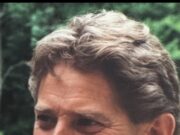Hiram – What really needed restoration at the end of the hike was my pair of boots, which were never intended to stand up to THAT much mud.
This was another adventure offered by the Friends of the Hiram Field Station, which has been organizing expeditions to quite a number of fascinating sites across northeast Ohio, in urban areas as well as wooded acreage, streams of all sizes, park acquisitions and cool stuff in general. Saturday, January 12 (You remember, the one-day summer that we had) was an exploration and overview of a new project undertaken by Hiram College (through the Field Station) in partnership with the Ohio EPA, the Davey Resource Group (An arm of the Davey Tree Expert Company), the Western Reserve Land Conservancy and the Metropolitan Sewer District of Greater Cincinnati (How’d they get into this in the far reaches of northeastern Ohio? It all has to do with the Ohio EPA Water Resource Restoration Sponsor Program–WRRSP–and the wonders of government financing. You don’t even want to know….). The goal is to reroute and restore the path of Eagle Creek–after its junction with Silver Creek–to slow the flow and allow the floodplain to function as a floodplain should, increasing the aquatic life of the stream, hydrating existing wetlands, improving water quality and decreasing the likelihood of damaging flooding downstream, i.e., downtown Garrettsville, for example. Riparian restoration at its finest!
The Field Station entrance is located on Wheeler Rd. but the project is on the south side of St. Rte 82, down over the hill. Drivers may have noticed an informational sign next to a new access drive (Which is NOT intended to be access for the general public and will be, in effect, closed after the project’s completion). This path is NOT the straight-and-narrow. It was the path used by the big excavation machines brought in by the Davey people to get to where they could move boulders, open the new stream channel, put dirt in new places and take it out of old places, move more boulders, plant trees (Ohio natives, all). Amazingly, the number of trees already in place which had to be removed was pretty small, due to great care and planning by the earthmover folks. This meandering path itself serves to divert and slow the downward flow of water heading toward Eagle Creek so that there is no “spillway effect” which would promote erosion and be at odds with the project’s purpose. New trees have been planted, mostly on the uplands but natural seeding will be part of the process from this point on.
By summer of 2013 the new channel should be complete and the stream re-routed into the new, curved, shallower channel. From the spring of 2013, monitoring and stewardship of the project will be under the direction of Hiram College faculty and staff, with contributions by citizen/scientists as part of the community involvement encouraged by Hiram College and the James H. Barrow Field Station.
The co-operating partners listed above are joined in the success of the project by: Roger Cram–photographer extraordinaire –who provided aerial photographs of the area, virtually from its inception to the last muddy boot tromping out of there; Isaac Yomtovian, who had purchased the property, originally, to do a housing development, but chose to sell to the WRLC, then Hiram College; the Frohring Foundation, which has furnished amazing support throughout the visualization and actualization stages (As it does for so many Hiram College projects).
The objectives–preservation of wetland habitat, hydrologic & biodiversity benefits, creation of a more shallow, natural stream with a restored floodplain, enhancement & restoration of habitat–will be measured by improvement in wetland and aquatic biodiversity, hydrologic enhancement for downstream communities and expanded educational & research opportunities for students, faculty and staff of Hiram College.
Watch for scheduling of occasional hikes under the aegis of the Friends of the Hiram Field Station as the project reaches maturity ( not all of the people on the hikes will be so mature; I missed seeing a fair amount of the nifty scenery while watching where to put my feet in the ooze and hoping not to have one–Or BOTH, God forbid–of my boots sucked off my feet to disappear forever into the muck. ALL of the wild blackberry and locust and junk rosebushes have survived–thorns intact–for the length of the trek, at least any of the places that I chose not to slog down the middle of the goo and headed to the sides…bad idea, and I’ve got the bloodstains to prove it.) The Field Station has hand-outs featuring really helpful diagrams and photographs.
Get tall boots.










